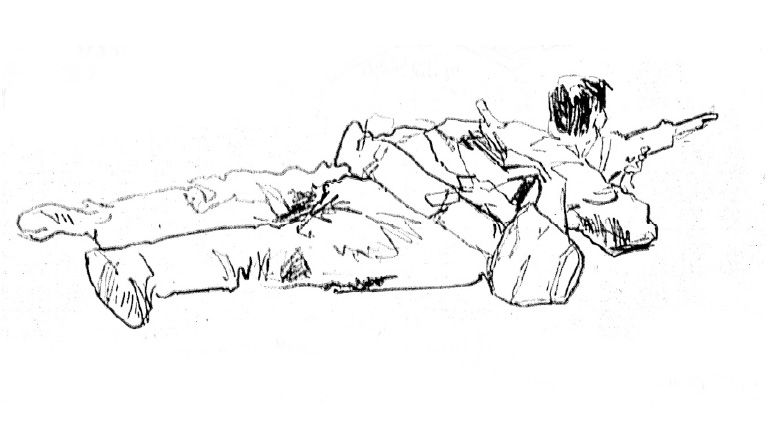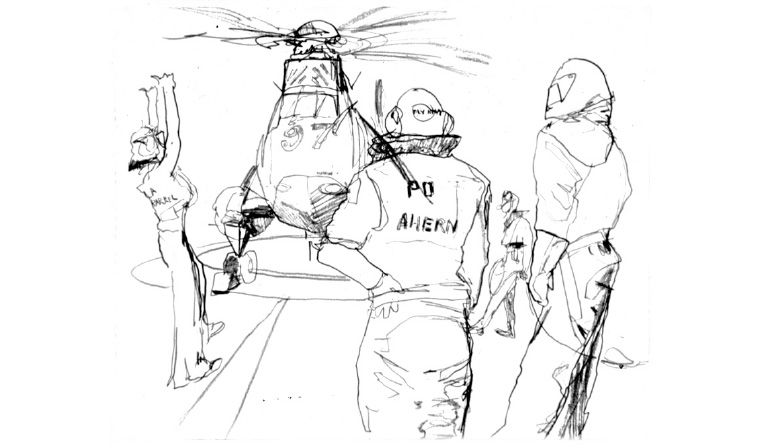The present refusal of the Ministry of Defence to release documents relating to the bombing of the RFA Sir Galahad by Argentinian aircraft on 8th June 1982, during the Falklands conflict, reflects a tradition of cover-up in the Royal Navy. It acted identically following the sinking of HMS Glorious on 8th June 1940 (an event that happened exactly 42 years, to the day, before the bombing of the Sir Galahad). That inglorious episode resulted in the single largest loss of life in the Second World War among our naval forces, and yet it was not until 1980 that the full shocking story of poor command and mismanagement by those responsible for the disaster became publicly known.
In the more recent case of the Sir Galahad, there has still not been a full release of all related documents. It has taken over 40 years of heartache and an enormous amount of research by the survivors—led by the veteran Crispin Black—for many disturbing facts to emerge. These are graphically described in Black’s book Too Thin for a Shroud.
The Sir Galahad, carrying the Welsh Guards, should never have been in Port Pleasant in the first place, which is where the Argentine air attacks actually took place. The war cabinet had deployed the 5th Infantry Brigade, including the Welsh Guards, only on the understanding that it would act as garrison in San Carlos Water and provide a reserve to 3 Commando Brigade, which, by 1st June, was poised to launch its final attack into Port Stanley. How the Sir Galahad came to be 170 nautical miles away in Port Pleasant in broad daylight, within sight of Argentine observation posts and without sufficient air defence, communications, means of disembarkation or even clear orders is the subject of Black’s excoriating book—in which he points an accusatory finger at Admiral Fieldhouse, overall commander in the Falklands, for failing to adhere to amphibious warfare doctrine, and Major General Jeremy Moore, the land force commander, for his “muddled wavering and his ingrained parochialism”.
Black rightly suggests that the fundamental causes of the disaster, however, lie much further away—at the top of the Royal Navy’s chain of command. For it was the first sea lord, Admiral Leach, who decided that the campaign should be prosecuted by one military service, the navy, and commanded by Admiral Fieldhouse, a submariner, from his headquarters in Northwood, England. In fact, there was no senior Army presence in that HQ until General Dick Trant arrived as Fieldhouse’s adviser one month after the start of the war—by which time it was too late for any proper military input into the land battle needed to retake the Falkland Islands.
Fieldhouse appears to have continued to believe that the mere arrival of the Royal Navy in the Falkland Islands, along with the landing of troops on the beach at San Carlos Water, would be enough to cause the Argentines to surrender. It was only during a visit to Northwood by the prime minister, Margaret Thatcher, who put a pin on Port Stanley on Fieldhouse’s map, firmly telling him that this was his objective, that attitudes finally changed.
It also did not help that Admiral Fieldhouse decided to command the land battle from Northwood. As one Royal Marine company commander laconically asked, “How could a submariner command a fast-moving land battle taking place 8,000 miles away from a bunker 100ft under Middlesex?” The answer is, of course, that Fieldhouse could not—and, as a result, early opportunities to defeat the Argentines were missed, and British and Argentine lives were unnecessarily lost.
Most notably, Fieldhouse’s order on 25th May to Brigadier Julian Thompson to attack the Argentine garrison at Darwin Goose Green made little military sense. Thompson had already given orders to fly 42 Commando from San Carlos Water to Mount Kent, which overlooked all the Argentine defensive positions in Port Stanley. The garrison in Darwin Goose Green was, in the words of the intelligence officer of 3 Commando Brigade, “merely a self-administering prisoner of war camp” that offered no threat to a British advance on Port Stanley. The attack, though successful, used up scarce resources, wasted time, and cost 18 lives and 64 soldiers injured.
Post facto, it was suggested that eliminating the garrison in Darwin Goose Green had helped to undermine Argentine morale. But how would that compare to having all their defensive positions around Port Stanley come under controlled British artillery fire?
Jeremy Moore, who had been appointed as land force commander by Admiral Fieldhouse, was a gallant, albeit old-fashioned, officer who had never commanded anything larger than a brigade—and then never on operations. Throughout the months of April and May, while in Northwood and travelling to the south Atlantic on the QE2, Moore appears to have refused to discuss any operational plan for an attack on Port Stanley, telling his staff that he would inform them of his plan on arrival in the Falkland Islands. This did not happen until 30th May, at which point Moore surprised everyone, including his own staff, by telling them that he was going to open a second front in the south using 5 Infantry Brigade.
In effect, the British would now be assaulting Port Stanley in a thin red line running from coast to coast, with limited communications and little-to-no air cover or reserve. By organising this, Moore breached almost every principle of war—notably those around concentration of force, maintenance of momentum, economy of effort, surprise and, indeed, morale. If a student at a staff college had come up with such a hopeless plan, they would have been sacked.
Moore’s deputy, Brigadier John Waters, strongly advised him against this course of action—especially as much of the 5th Brigade’s logistic equipment and transport, including helicopters, had been lost on the Atlantic Conveyor. Waters was ignored. At that time, 3 Commando Brigade was poised near Estancia House, only 10 miles from Port Stanley, and ready to launch its final attack—Brigadier Julian Thompson believed it could have been completed within a week. His attack had to wait for a further 12 days, giving the Argentines that time to prepare their defences.
Moore, however, was set on his Great Leap Forward. In the next eight days, ships would be lost and men would die without significant military gain. The subsequent story of the bombing of the Sir Galahad and the destruction of the Welsh Guards, as related by Black, is one of continuing chaos and muddle.
Immediately after the disaster, the blame game started—with senior officers in the Royal Navy and Royal Marines openly seeking to blame the Welsh Guards and the Army for what Black calls a “cascade of crass blunders”, rather than admit their own responsibility. It was claimed, for example, that the Welsh Guards were a London “public duties” battalion whose men were unfit and unable to march with heavy equipment across the exposed and hostile terrain of the Falkland Islands. In fact, the Welsh Guards had just completed a tour of duty as the UK’s spearhead battalion, and its men were therefore probably better trained and certainly as fit as any other infantry battalion in the Army.
The second accusation levelled against the Welsh Guards is that Major Guy Sayle, the senior Welsh Guards officer on board the Sir Galahad, refused to leave the ship when invited to do so by the Royal Marine officer in charge of the naval landing craft on the morning of 8th June. The inference is that Sayle was therefore somehow responsible for the disaster. In fact, Sayle’s orders from Moore were to land the two Welsh Guards companies in Bluff Cove, where they would join the rest of the Welsh Guards battalion. However, the Welsh Guards companies had unexpectedly found themselves in Port Pleasant, and if they had disembarked there, then “H Hour”—that is, the main attack on Port Stanley—would have been delayed by at least 24 hours. Fieldhouse, in his campaign report, calls Sayles’s decision “justified and prudent”.
The Royal Marine officer who had not been able to rendezvous with HMS Fearless (the Amphibious Task Force command ship) with two LCUs (landing craft) the night before, and thereby transfer the Welsh Guards to Bluff Cove, later said that “I was not prepared to explain the real reason for my inactivity and just let everyone think it was purely the bad weather.” As a result, only half the Welsh Guards could be offloaded that night using HMS Fearless’s two remaining LCUs, and the rest had to be moved the next night on the Sir Galahad.
The accusations levelled at the Welsh Guards therefore—conveniently—do not address how the Sir Galahad had been wrongly sent by the Royal Navy to Port Pleasant. They also fail to explain why there was only one LCU in Port Pleasant available to move the Welsh Guards to Bluff Cove when they did finally arrive. This LCU was already loaded with ammunition, and it was deemed more important to unload munitions and the field ambulance from the Sir Galahad before the Welsh Guards. Thus disembarkation of the latter did not begin until over six hours after their arrival in Port Pleasant—and this is when the Argentine air attacks took place. Importantly, Black also points out that the previous day there had been six LCUs in Port Pleasant, but inexplicably all bar one had been withdrawn by the Royal Navy—four sent back to San Carlos Water and one to Darwin Goose Green, which was tragically sunk en route by an Argentine attack, with the loss of five lives.
Black also reveals that Moore had unwisely decided to sail HMS Fearless, on the night of 7th June, out of San Carlos Water to Teal Inlet—in spite of the fact that it was difficult to communicate from there to Fitzroy, which is where the 5th Infantry Brigade had established its HQ. In doing so, he effectively cut himself off from all forward communications during the most critical period in his plan. As a result, he missed opportunities to impose order on a fast-deteriorating tactical situation. For example, he could have delayed the move of the Sir Galahad by 24 hours, which had been asked for by Phil Roberts, the ship’s captain; he could have cleared up the confusion about its true destination; and, at the least, he could have ensured that there were sufficient tank landing craft in Port Pleasant. Until now, all these facts have been concealed by a smokescreen of accusation.
Too Thin for a Shroud can be difficult to follow, as Black provides in detail the critical timings, movements, orders and locations of units and ships during that period. But, throughout, the message is clear: the Welsh Guards and all those who died that fateful day were the hapless victims of muddle—not the perpetrators of the disaster. Eyewitness accounts by three of Black’s colleagues, included in his book, strongly support this view.
Wars are rarely won by the genius of admirals, generals or air marshals. They are won by the determination, ingenuity and selfless commitment of individual sailors, soldiers and airmen. The Falkland Islands War was a great British victory won at 8,000-miles distance, against a numerically superior enemy, in a hostile climate and environment. Now it would seem the war was also won in the face of gross ineptitude and a refusal to listen by some senior Royal Navy and Royal Marine commanders.
Surely it is time that those who, in the words of one young Welsh Guardsman on board the Sir Galahad, “for 41 years have felt nothing but blame and unworthiness for their role” be allowed to see the full report into what happened on 8th June 1982. And for those who were actually responsible to finally be held to account.
















